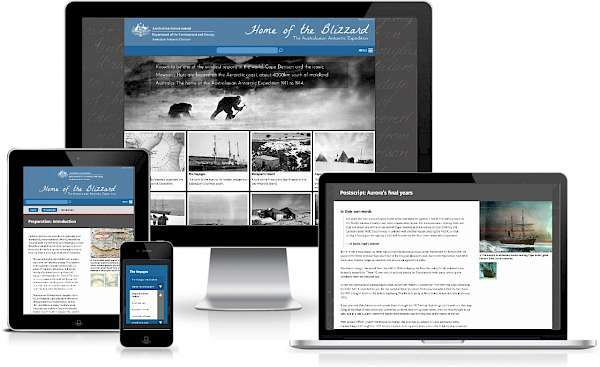In the 266th issue of ProcessWire Weekly we're going to take a closer look at ProcessWire 3.0.133 (dev), introduce a third party module called Repeater Images, and highlight a recently released site belonging to the Australian Antarctic Division. Read on!
Welcome to the latest issue of ProcessWire Weekly. This time we're thrilled to say that there are some really notable new features in the core – perhaps most notably a new way to store metadata related to Pages without going through the process of adding custom fields for it. We'll talk more about this in just a bit!
This week we've also got a new module from Robin Sallis, called Repeater Images, and a really nice new site of the week belonging to the Australian Antarctic Division. Repeater Images provides an interesting implementation for the page-per-image strategy, while the site of the week – Home of the Blizzard – contains loads of information about the legendary 1911-1914 antarctic expedition by Australian geologist Douglas Mawson.
Thanks to all of our readers for being here with us again, and as always, any feedback is most welcome – please don't hesitate to drop us a line if there's anything in your mind you'd like to share with us. Enjoy our latest issue and have a great weekend!
Latest core updates: ProcessWire 3.0.133
In the latest post at the processwire.com Ryan walks us through the new features added to the core in ProcessWire 3.0.133, our latest development release. In total this version adds three new features: new meta() method for Page objects, Lister bookmarks for individual (non-superuser) users, and support for collapsed-by-default "sub-lists" of selectable items for AsmSelect.
New $page->meta() method
Page objects (and objects with a class derived from Page, such as users, roles, permissions, and languages) now have a new method called meta(). What this method does is that it stores "metadata" related to that page into a separate database table. This metadata is separated from regular field data and not searchable using ProcessWire's API, and as such it's likely best suited for something that you don't want to display in the admin as editable data (configuration settings, something added by a third party module, or perhaps some sort of cache data).
Read more about the $page->meta() method »
Lister bookmarks for regular users
Previously Lister bookmarks were a feature that only superusers could create and share with other users. As of ProcessWire 3.0.133 non-superusers can also create their own bookmarks, and though by default these are only visible to the user that created them, they can also share their own bookmark URLs with other users.
Read more about per-user Lister bookmarks »
Collapsible sub-trees for AsmSelect
As you probably know, AsmSelect is a really handy tool for selecting multiple items from a dropdown list and then re-ordering them the way you want. What AsmSelect hasn't been really great for is a case where you've got loads of items to select from, but as of ProcessWire 3.0.133 the core AsmSelect implementation now supports collapsible "sublists" of items, where you can group multiple items under one heading that opens once you click it, revealing its contents.
Note: currently the collapsible feature is used only by the development version of the ListerPro module, but since support for this is in the core AsmSelect feature, it can be added to other places as well in the future – whether built-in features such as Page fields, or those implemented by other third party modules.
Read more about collapsible AsmSelect sub-trees »
You can read more about each new feature mentioned above from the latest post at the processwire.com blog, or by following the links above. This week's features were sponsored by Innovation, Science and Economic Development Canada – big "thank you" to ISED for supporting the development of ProcessWire!
New module from Robin Sallis: Repeater Images
Repeater Images is the latest module from Robin Sallis, and a really nice solution for adding additional details – metadata, or something else entirely – to images without sacrificing the clarity of the admin screen.
This module implements the strategy commonly know as page per image, where you actually create a page for each embeddable image, select that page when you want to embed the image in question, and handle the rest programmatically on your template files. This strategy is really handy if you don't just want to display the image, but also additional details about it: author information, location data, etc.
The gist of this module is that instead of creating pages in the page tree, it makes use of the Repeater field type, and stores each image as a repeater item. Since that alone wouldn't be particularly interesting in itself – you can already do it with built-in tools – the module modifies the UI so that a Repeater field with Repeater Images enabled will by default look almost identical to a regular image field – but when you click an image, it'll expand to a full-blown repeater item:

Big thanks to Robin for sharing this module with us – brilliant idea, and we're sure this module will come in handy for a number of projects out there!
Site of the week: Home of the Blizzard by the Australian Antarctic Division
 Our latest site of the week is called Home of the Blizzard, and it's a website that outlines Douglas Mawson's historical Australasian Antarctic Expedition of 1911 to 1914. This site was developed in-house by the Australian Antarctic Division, and though the release of this site was pushed a bit further due to other, more time-sensitive projects, it's actually the first ProcessWire powered website they started working on.
Our latest site of the week is called Home of the Blizzard, and it's a website that outlines Douglas Mawson's historical Australasian Antarctic Expedition of 1911 to 1914. This site was developed in-house by the Australian Antarctic Division, and though the release of this site was pushed a bit further due to other, more time-sensitive projects, it's actually the first ProcessWire powered website they started working on.
The Home of the Blizzard isn't the most gorgeously visual website we've featured, but content-wise it's a real treat – or perhaps an adventure. There's a lot of content here, and it's well organized, so we'd definitely recommended checking out the story of the 1911-1914 expedition in full. From the preparations to the eventual homecoming, this site provides all the details you could possibly hope for, and there's a database of related information (including videos and links to other websites) as well.
Behind the scenes the website uses Fancybox for the image galleries and the modal menu, Plyr for embedded video content, and Modernizr. There's no full-blown front-end framework in play here: the site is hand-crafted with custom styles, and the grid is built with CSS grid. This decision contributes to the fact that the site is quite thin, as there are very few unnecessary styles or scripts to load – always a good idea from a performance point of view!
Big thanks to the Australian Antarctic Division for sharing this site with us, and trusting ProcessWire for your projects in the first place – glad to have you folks on board!
Stay tuned for our next issue
That's it for the 266th issue of ProcessWire Weekly. We'll be back with more news, updates, and content Saturday, 22nd of June. As always, ProcessWire newsletter subscribers will get our updates a few days later.
Thanks for staying with us, once again. Hope you've had a great and productive week, and don't forget to check out the ProcessWire forums for more interesting topics. Until next week, happy hacking with ProcessWire!
Post a comment